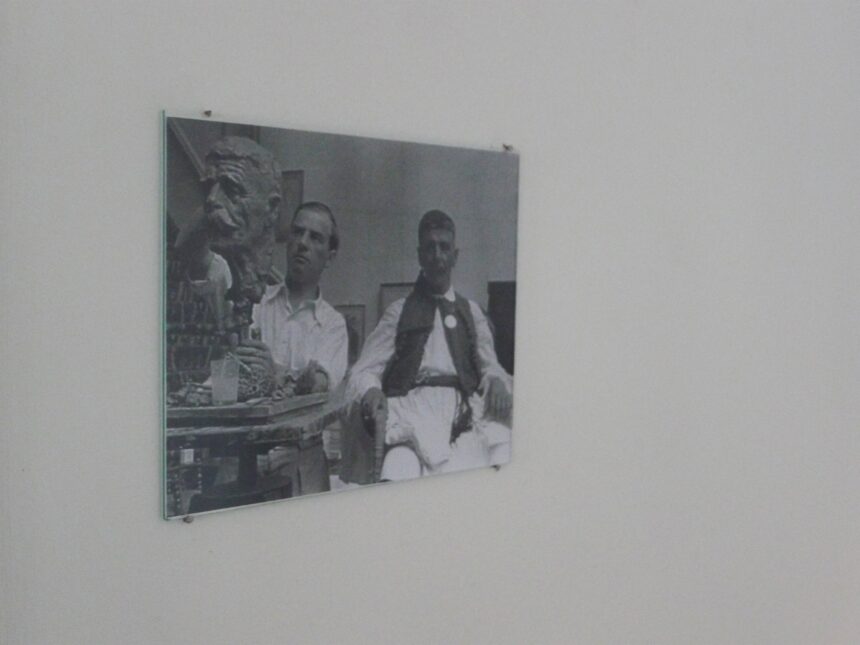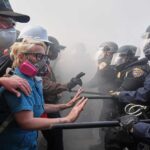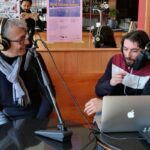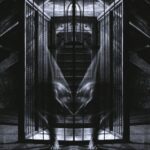The encounter: An epistolary story [1]
Natasa Biza, visual artist

ἐπιστολή epistolē, epistle, meaning a letter or message
Note 1: The photograph [2]
The photograph depicts Spyros Louis, the legendary Greek Olympic champion, posing for a bust at Arno Breker’s studio in 1936 Berlin. On the left side of this black-and-white photograph, the sculptor is captured working on the back of thebust in a restrained and concentrated motion. On the right side, the sculptor’s model is seen from the front, facing us directly and wearing a nineteenth-century white shirt with the characteristically large sleeves, dressed in the vest of a Evzones costume [3]. On the left side of the vest, he bears the medal awarded to him at the first modern Olympic Games in Athens in 1896, while his right shoulder is covered with the impressively rich tassel of his fez that is worn at a slight tilt. On his right hand resting on the arm of his chair, he wears his wedding ring. The sculptor has captured the model’s facial characteristics with clarity and finesse. Although the bust is placed in the forefront, it is not the central focus of the picture. The composition is dominated by the figures of the sculptor and his model in the middle ground.
*
Epistle 2, 12 December, 20:31, 2016 [4]
Re: Permission for the use of the photo Arno Breker and Spiros Louis
Dear Mrs Biza
In reply to your mail I like to say, we cannot understand, what you really want and for what purpose.
Regarding your Request of the image “Arno Breker, sculptor of the third Reich, sculpting the bust of Spiros Louis, Berlin, 1936”
The fact, that Breker (he was married to a Greek lady) has suggested to Adolf Hitler to honour the famous Greek Spiros Louis by making a bust and he gladly agreed is a great decision.
Spiros was highly honored at the Olympic Games in Berlin 1936, as well the crown prince of this time who became the King of the Hellenes and met serveral times with Arno Breker in Berlin.
Spiros was a guest of honour and invated cby the German Government. He was Posiong fopr the bronz bust in Arno Brekers private Studio to avoid
disturbences during the work. (I came to know later Queen Fridericke the German princess and Granddoughter of the last German Kaiser (Emporer)
This I all liked to tell you, what good relations existed between Berlin and Athens.
Yours J. B. author of the biography Arno Breker.
end
*
Note 2: Demetra [5]
Demetra Messala met Arno Breker, the official sculptor of the Third Reich, in the early 1930s [6]. While she lived in Paris, Demetra modeled for Picasso and Maillol. In 1937, Messala and Breker got married. The same year Breker was appointed professor at the Academy of Fine Arts in Berlin. The Brekers were part of Hitler’s close-knit social circle. Hitler developed a soft spot for Demetra when, at a series of Nazi meetings at Berghof, she “read” his palm [7].
Notes
[1] This short story is articulated as a series of documents blurring the line between real-life facts and fiction. Drawing from the photograph that is “transcribed” in the first part of my epistolary story, I developed a work entitled ‘The Encounter’ in which I allegorically explored the relations between Germany and Greece, an issue that was one of the main concerns of art criticism at the 14th edition of documenta. This work was presented as a performance at the closing event of the research project Learning from documenta. The performance took the form of a conference panel where two Greek artists (myself and Alexis Fidetzis) along with the art historian Katerina Konstantinou read three epistles written in three different languages–Greek, English, and German. This work comments on both the massive publication production of d14 in those three languages and the multiple ways in which the exhibition was related to the Greek context.
[2] It only takes two keywords such as “Breker” and “Louis” for Google to find some hundreds of digital reproductions of this image. It is indeed widely circulated on the web, yet I was unable to locate the original print.
[3] The Evzones is a ceremonial unit of the Greek army that today guards the Greek Parliament and the Presidential Mansion in Athens.
[4] I received this epistle in response to my initial inquiry, the primary aim of which was to locate at least one print of the original image. I may have frustrated the recipient of my inquiry and therefore his response is oddly written, yet it offers indicative data. It reveals a different point of view according to which at the time when the picture was taken, the relations between Athens and Berlin were “good”. A copy of the email is adduced so that every cultural or behavioral aspect of the language as well as its stylistics are available to the reader. Punctuation, grammar, and syntax are maintained as in the original text.
[5] Palm reading is a way of learning. Despite all the effort that has been made to establish a certain methodology or a set of rules for it, it remains undisciplined and unprincipled.
[6] Jonathan Petropoulos, The Faustian Bargain: The Art World in Nazi Germany (Oxford: Oxford University Press, 2002) p.221.
[7] Titos Patrikios, Περιπέτειες σε τρεις σχεδίες [Adventures on three drafts]. (Athens: Kedros, 2006).


Natasa Biza studied at the Athens School of Fine Arts (2012) and the ‘Academia di belle arte’ in Rome (2010). She also obtained a Master in Fines Arts from the Athens School of Fine Arts (2014). The artist applies methods that are culled from the fields of archaeology, history and anthropology such as archival research and interviews with people. Through analyzing her findings, she raises issues concerning the power of institutions such as archives, libraries, and museums to produce knowledge and the politics of memory in the ordinary activities of collecting, storing, preserving, archiving and exhibiting. By forming new collections or by re-interpreting archival material in her lecture-performances, books and installations, she questions existing authority and power over the narration of the past, and also introduces alternative narratives.







